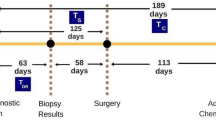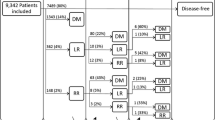Abstract
Introduction
The risk of breast cancer recurrence has been linked to tumour size, grade, oestrogen (ER) receptor status, and degree of lymph node (LN) involvement. However, the role of these variables in predicting time to relapse is not well defined. This study was designed to identify patient and primary tumour characteristics that predict risk periods for breast cancer recurrence within our institution, to enable more tailored surveillance strategies.
Methods
We retrospectively studied a cohort of 473 patients who presented to The Queen Elizabeth Hospital, Adelaide, Australia, with recurrent breast cancer between 1968 and 2008. Patient and primary tumour characteristics were collected, including age, menopausal status, tumour grade, size, ER and progesterone receptor (PR) status, and LN involvement and modeled against time to relapse using Kaplan–Meier survival curves.
Results
High tumour grade, size ≥20 mm, ER negativity, and PR negativity were shown on univariate analysis to correlate significantly with earlier recurrence (P < 0.0001, P = 0.0012, P = 0.0006, and P = 0.006). Multivariate analysis identified tumour grade and size as significant predictors of timing of relapse after adjustment for other variables. LN involvement, menopausal status, and age did not significantly correlate with earlier recurrence.
Conclusions
High tumour grade and larger size were shown to independently predict earlier breast cancer relapse. While LN involvement increases absolute recurrence risk, our study proposes that it does not influence timing of relapse. Use of these predictors will enable key risk periods for onset of relapse to be characterised according to tumour profile with more appropriate discharge to primary care providers for ongoing surveillance.







Similar content being viewed by others
References
Brewster AM, Hortobagyi GN, Broglio KR et al (2008) Residual risk of breast cancer recurrence 5 years after adjuvant therapy. J Natl Cancer Inst 100(16):1179–1183
Recht A, Gray R, Davidson NE et al (1999) Locoregional failure 10 years after mastectomy and adjuvant chemotherapy with or without tamoxifen without irradiation: experience of the Eastern Cooperative Oncology Group. J Clin Oncol 17(6):1689–1700
Voogd AC, Nielsen M, Peterse JL et al (2001) Differences in risk factors for local and distant recurrence after breast-conserving therapy or mastectomy for stage I and II breast cancer: pooled results of two large European randomized trials. J Clin Oncol 19(6):1688–1697
Wallgren A, Bonetti M, Gelber RD et al (2003) Risk factors for locoregional recurrence among breast cancer patients: results from International Breast Cancer Study Group Trials I through VII. J Clin Oncol 21(7):1205–1213
van der Leij F, Elkhuizen PH, Bartelink H et al (2012) Predictive factors for local recurrence in breast cancer. Semin Radiat Oncol 22(2):100–107
Panoff JE, Hurley J, Takita C et al (2011) Risk of locoregional recurrence by receptor status in breast cancer patients receiving modern systemic therapy and post-mastectomy radiation. Breast Cancer Res Treat 128(3):899–906
Neri A, Marrelli D, Rossi S et al (2007) Breast cancer local recurrence: risk factors and prognostic relevance of early time to recurrence. World J Surg 31(1):36–45. doi:10.1007/s00268-006-0097-2
Lowery AJ, Kell MR, Glynn RW et al (2012) Locoregional recurrence after breast cancer surgery: a systematic review by receptor phenotype. Breast Cancer Res Treat 133(3):831–841
Dent R, Trudeau M, Pritchard KI et al (2007) Triple-negative breast cancer: clinical features and patterns of recurrence. Clin Cancer Res 13(15 Pt 1):4429–4434
Demicheli R, Abbattista A, Miceli R et al (1996) Time distribution of the recurrence risk for breast cancer patients undergoing mastectomy: further support about the concept of tumor dormancy. Breast Cancer Res Treat 41(2):177–185
Mansell J, Monypenny IJ, Skene AI et al (2009) Patterns and predictors of early recurrence in postmenopausal women with estrogen receptor-positive early breast cancer. Breast Cancer Res Treat 117(1):91–98
Yin W, Di G, Zhou L et al (2009) Time-varying pattern of recurrence risk for Chinese breast cancer patients. Breast Cancer Res Treat 114(3):527–535
Mauriac L, Keshaviah A, Debled M et al (2007) Predictors of early relapse in postmenopausal women with hormone receptor-positive breast cancer in the BIG 1-98 trial. Ann Oncol 18(5):859–867
Song WJ, Kim KI, Park SH et al (2012) The risk factors influencing between the early and late recurrence in systemic recurrent breast cancer. J Breast Cancer 15(2):218–223
Hess KR, Pusztai L, Buzdar AU et al (2003) Estrogen receptors and distinct patterns of breast cancer relapse. Breast Cancer Res Treat 78(1):105–118
Pagani O, Price KN, Gelber RD et al (2009) Patterns of recurrence of early breast cancer according to estrogen receptor status: a therapeutic target for a quarter of a century. Breast Cancer Res Treat 117(2):319–324
Demicheli R (2001) Tumour dormancy: findings and hypotheses from clinical research on breast cancer. Semin Cancer Biol 11(4):297–306
Demicheli R, Bonadonna G, Hrushesky WJ et al (2004) Menopausal status dependence of the timing of breast cancer recurrence after surgical removal of the primary tumour. Breast Cancer Res 6(6):R689–R696
Acknowledgments
This study required no external sources of funding. The authors are grateful to the following people for their help: Mr. Thomas Sullivan and Mr. Stuart Howell at the University of Adelaide Discipline of Public Health for providing statistical support; Ms. Margaret Colbeck, Department of Medicine at The Queen Elizabeth Hospital for maintaining the hospital’s cancer registry database; and Mrs. Teresa Occhiodoro-Scott, B.Sc (Hons), Department of Surgery at The Queen Elizabeth Hospital for her assistance with data collection.
Conflict of interest
There are no identified conflicts of interest.
Author information
Authors and Affiliations
Corresponding author
Additional information
Danielle J. Fitzpatrick and Christine S. Lai contributed equally to this work.
Rights and permissions
About this article
Cite this article
Fitzpatrick, D.J., Lai, C.S., Parkyn, R.F. et al. Time to Breast Cancer Relapse Predicted By Primary Tumour Characteristics, Not Lymph Node Involvement. World J Surg 38, 1668–1675 (2014). https://doi.org/10.1007/s00268-013-2397-7
Published:
Issue Date:
DOI: https://doi.org/10.1007/s00268-013-2397-7




